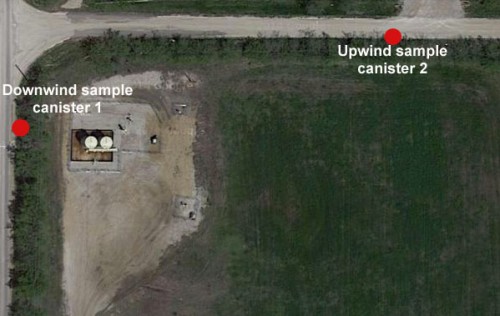
On October 18, 2014, Cathy McMullen and I took air samples at the EnerVest drill site on Masch Branch and Hampton in Denton, Texas. Wind direction was ENE at 4.5 mph.
The downwind sample detected 18 toxic and hazardous gases and methane. Benzene was detected over the TCEQ’s Air Comparison Monitoring Value for long-term exposure.
Canister #AC00848 – Downwind – 11:30am
Methane 3.2 ppm
1. Dichlorodifluoromethane (CFC 12) 0.42 ppb
2. Acetone 3.6 ppb
3. Trichlorofluoromethane 0.20 ppb
4. n-Hexane 25 ppb
5. Benzene 1.5 ppb
6. Cyclohexane 5.0 ppb
7. n-Heptane 9.0 ppb
8. Toluene 3.7 ppb
9. n-Octane 4.7 ppb
10. Ethylbenzene 1.4 ppb
11. m,p-Xylenes 3.9 ppb
12. o-Xylene 1.6 ppb
13. n-Nonane 5.9 ppb
14. Cumene 0.36 ppb
15. n-Propylbenzene 0.97 ppb
16. 4-Ethyltoluene 1.1 ppb
17. 1,3,5-Trimethylbenzene 0.88 ppb
18. 1,2,4-Trimethylbenzene 3.0 ppb
To learn how a mix of chemicals, even at low levels, can effect your health, see Chemical toxicology in the fracking zone and Study: Co-exposures of two chemicals at safe levels doubles chances of cancer.
The upwind sample detected three toxic and hazardous gasses and methane.
Canister #003497 – Upwind – 11:35am
Methane 3.9 ppm
1. Dichlorodifluoromethane (CFC 12) 0.42 ppb
2. Acetone 4.8 ppb
3. Trichlorofluoromethane 0.20 ppm
Map of sampling locations:
The TCEQ will dismiss this air test saying it is a one-time exposure so health effects cannot be expected. But we have FLIR videos that show these kinds of emissions are occurring over the long-term in Denton. We also have numerous air samples where benzene and other hazardous gases were detected over TCEQ limits. Most of this air testing was done by citizens or at their expense. Neither the city nor the state have implemented any kind of air monitoring program. This testing shows a pattern of long-term exposure for the citizens of Denton that is consistent with findings in other areas.
Scientific studies from research groups are finding much larger volumes of toxic air pollutants near oil & gas operations than state and federal regulators estimate, and people living near these operations are having health impacts.
Researchers assess emissions from Colorado oil and gas fields
By Mark Jaffe, 11/16/2014
The Denver PostWhat researchers are finding is that the levels of chemicals such as benzene and toluene, which may pose health risks, can be higher around oil and gas sites than in big cities.
If you live in the gas patch or care about climate, please read the entire article. Here are a few things that jumped out at me.
A University of Colorado study measured levels of benzene, a known carcinogen, over the Front Range oil fields seven times higher than state estimates.
A study in Utah’s Uintah Basin, also by CU scientists, found benzene levels above a long-term exposure health standard in three-quarters of the 329 air measurements made.
“We are looking at emissions that are significantly larger — perhaps 50 percent larger,” than state estimates, said NOAA’s Tans.
Bottom up (measurements taken on the ground) can pinpoint the source of the leaks but scientists who do top down (measurements taken from the air above facilities) say bottom up studies consistently underestimate emissions.
The EnerVest rig foreman explained to a news reporter and me that the gas buster removes gas from fluids and mud that have been used downhole while drilling in the formation. EnerVest was allowing this gas to vent from the gas buster into the air, but routing the gas through a flare is a safer method.
Principle of Operation of Mud Gas Separator:
“The free gas then is moved into the flare line to reduce the threat of toxic and hazardous gases…”
As the rig foreman explained, they had a flare for the gas buster on site but chose to not connect it and use it.
Here is a FLIR video I took that shows the toxic and hazardous gases venting into the air from the gas buster at the EnerVest drill site.
Venting from the gas buster was not the only source of emissions from this rig as is clearly shown in the other FLIR videos.
9-9-2014 http://youtu.be/SG48hMXV3Ss
9-30-2014 http://youtu.be/RNhJMJ_rYkI
10-9-2014 http://youtu.be/qbyCAias2MI
10-11-2014 http://youtu.be/AdlvF3VbceI
“Responsible Drilling” like the unicorn is a myth.
About Sharon Wilson
Sharon Wilson is considered a leading citizen expert on the impacts of shale oil and gas extraction. She is the go-to person whether it’s top EPA officials from D.C., national and international news networks, or residents facing the shock of eminent domain and the devastating environmental effects of natural gas development in their backyards.
- Web |
- More Posts(5121)